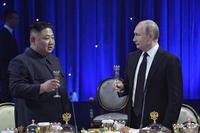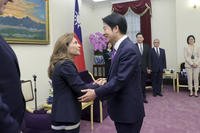
Lt. Gen. Stilwell talks to Meyer at CCN during inspection.
Since it was veterans day, I wanted to reach out to some of our vets to help us remember America's previous conflicts. It's a great honor to be able to introduce to you my buddy, John Stryker Meyer. John served in MACV-SOG, attaining the position of One-Zero, Team Leader, of Recon Team Idaho. Having led cross border operations into Laos and Cambodia, John was sworn to secrecy for decades. It is only now that he, and other SOG veterans, are able to tell their story. Since Kit Up! focuses on weapons and equipment, I asked John to tell us a little about what he carried during his time in Studies and Observations Group:
Veterans Day 1968 we were too busy running a mission into Laos with Spike Team Idaho to stop and honor veterans. And, on Nov. 11, 2011 I shall be in Nashville where Special Forces veteran Douglas L. "The Frenchman" LeTourneau will receive his Purple Heart for wounds received Thanksgiving Day 1968. Doug and I served in MACV-SOG, the Military Assistance Command Vietnam - Studies and Observations Group, the top secret war conducted for eight years during the Vietnam War. Doug and I served on recon teams that ran missions into N. Vietnam, Laos and Cambodia.
From my book Across The Fence: The Secret War In Vietnam, here's an excerpt on what I carried for weapons/firepower:
The most important piece of equipment we carried was the CAR-15. The sling for it would vary: sometimes I used a cravat or a canvas strap taped tightly to both ends of the weapon for soundless movements. That was the preferred weapon of choice by everyone on ST Idaho. The only exception was an AK-47 for Son when he was our point man wearing an NVA uniform, and an M-79 carried by our grenadier. In November 1968, Henry King carried the experimental pump M-79 weapon on one mission. It held up to five rounds of 40 mm high explosive ammunition. His secondary weapon was the Model 1911 Colt .45. On occasions, Black would carry the M-60 machine gun.
Every American on ST Idaho carried a sawed-off M-79 for additional firepower. We thought of it as our hand-held artillery. During patrol, the Americans would load a special M-79 round with fleshettes or double-ought (00) buckshot for close contact. The sawed-off M-79 would be secured either with a canvas or rope lanyard or a D-ring that was covered with black electrical tape to prevent any metallic banging. During the fall of 1968, I had a one-of-a-kind sawed-off M-79 holster, which I lost in when I was unconscious after a rope extraction in Laos.
I would carry at least thirty-four 20-round magazines for the CAR-15 – we only placed 18 rounds in each magazine, which gave me 612 rounds for that weapon, and at least 12 rounds for the M-79. The CAR-15 magazines were placed in ammo pouches or cloth canteen pouches, with the bottoms facing up to prevent debris from getting into the magazine and all of the rounds pointing away from the body. We taped black electrical tape to the bottom of each magazine to make it easier to grab them out of the pouch during firefights. I also carried 10 to 12 fragmentation grenades, a few of the older M-26, the newer M-33 “baseball” grenades and one or two V-22 minigrenades.
John Stryker Meyer's memoir, Across the Fence and the follow up, On the Ground are both available for the Kindle E-reader.
Kit up with MACV-SOG and John Stryker Meyer
© Copyright 2024 Military.com. All rights reserved. This article may not be republished, rebroadcast, rewritten or otherwise distributed without written permission. To reprint or license this article or any content from Military.com, please submit your request here.








